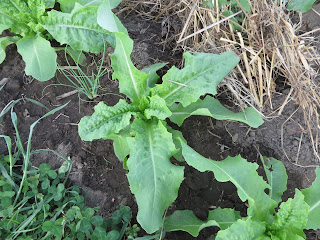 The first round of peas are just starting to flower. Fairly good timing, there will be a small handful of peas next week (my lunch; or taste testing if you will). By the time our weekly harvest resumes on the 21st, the first two beds will be in full flush and i will be practicing my picking skills.
The first round of peas are just starting to flower. Fairly good timing, there will be a small handful of peas next week (my lunch; or taste testing if you will). By the time our weekly harvest resumes on the 21st, the first two beds will be in full flush and i will be practicing my picking skills. Shall we get the long, slender fruits this season?
This is why planting heavy feeders in well developed beds is important...

It is said that one should reserve the best beds for onions.
Onions (and other aliums such as garlic) have very short root systems. As such, they do not tolerate competition very well for water or nutrients.
As well, their fine leaves cannot compete for sunlight.
Being a long season crop with a lot of complex chemistry going on inside them, they require a very fertile soil.
 When choosing where to plant the onions and garlic, the first consideration for me is the rotation pattern. According to some growers, the rotation pattern is responsible for up to eighty per cent of the growing fields fertility development.
When choosing where to plant the onions and garlic, the first consideration for me is the rotation pattern. According to some growers, the rotation pattern is responsible for up to eighty per cent of the growing fields fertility development.The next consideration I use is what crops were in the bed the previous year (some crops are better at suppressing weed growth), how much disturbance did the bed receive over the past season (again, related to which crop was there - eg, harvesting carrots will stir up more of the weed seed bank than say harvesting beets).
And finally, how many applications of compost did this bed receive in the previous year?
 Another crop I hope to improve upon this season, the celtuce, or Chinese lettuce.
Another crop I hope to improve upon this season, the celtuce, or Chinese lettuce.Last season was the first try at this crop. The leaves of celtuce are edible, but the stalk is the main attraction.
Last year, I planted this in leaf beds, and the result was a leafy plant with small stalks.
This season, I opted to plant these in a fruit bed, which would have been a leaf bed last season. The leaf crops will have taken a lot of the leaf building nitrogen out of the soil, allowing the plant to feed on the other nutrients to build up a rich tasting stalk.
Here is the start of the third round of carrots...which colors this season?
 Much more lettuce on the way. With luck, there is three succession in this picture, starting with late June and on into the first two weeks of July.
Much more lettuce on the way. With luck, there is three succession in this picture, starting with late June and on into the first two weeks of July.The luck is primarily about the red lettuce seen near the top of this photo. It is a red leaf called Merlot.
I tried it last year and it was clearly not a deep sumer lettuce, most of it went to seed two weeks before maturity date.
I planted some this year for late spring, and with luck, the May heat wave we experienced won't have damaged it too much.
A later succession of this variety didn't make it, a combination of too much heat and possibly a less than adequate job of hardening it off.
 Amazing what mowing the paths will do...a farm rises out of the underbrush.
Amazing what mowing the paths will do...a farm rises out of the underbrush. If only the row covers were not necessary....




